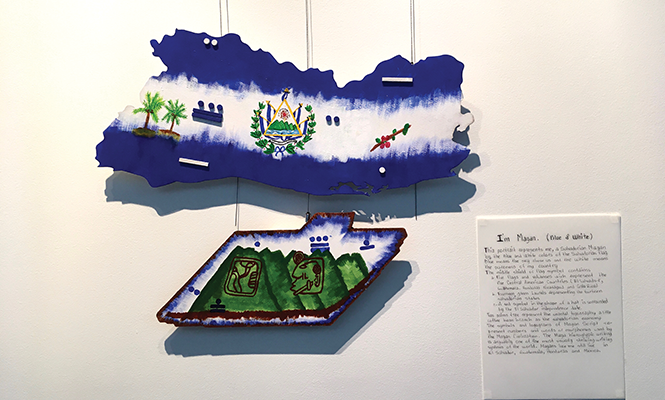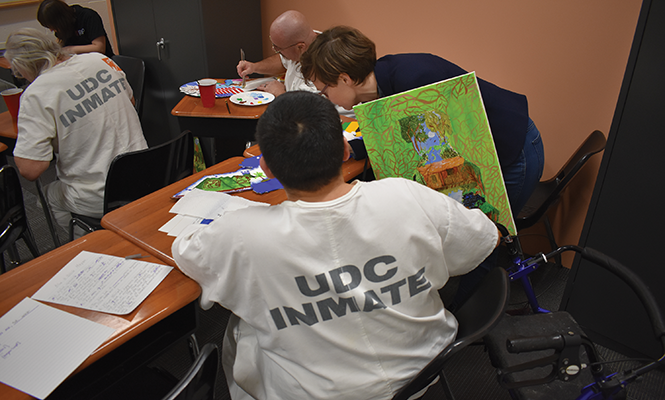University of Utah STEM Community Alliance Program Arts & Justice Lab
Incarcerated artists share their individual selves through arts classes.
By Scott Renshaw @scottrenshawThis is not a "white savior" story. Mollie Hosmer-Dillard doesn't come at her work that way.
It would be easy to see things from the perspective of that pop-culture trope, as Hosmer-Dillard—Art Manager for the University of Utah's Arts & Justice Lab—works with incarcerated adults and youth teaching visual-art programs. But she never wants it to be all about what she's doing for others from some elevated perch. "My perspective now is, human beings are a community," Hosmer-Dillard says. "I feel like I learn a lot from my students about the ills of society. I think tuning in to that keeps everything in check and keeps me on a course to make this about everyone's liberation.
A trained painter, Hosmer-Dillard lived and worked in Berlin and New York before attending graduate school with a goal of teaching. While at her first post-grad-school job teaching at Utah Tech, she learned about their program in higher education for incarcerated youth—"and it really spoke to me," she says.
She has always been conscious, however, of the extent to which the system in which she's working isn't a level field. "Even before I was teaching in these spaces, I was gaining and cultivating a sensitivity to power dynamics in teaching," Hosmer-Dillard says. "And that exists in any teaching situation. In carceral spaces, that power differential is way extreme. I go in, and I'm a white woman being paid to teach, and my students are disproportionately non-white, disproportionately with disabilities of various kinds, disproportionately from low income, and they aren't able to leave. My goal has been bridging that gap. I'm no longer the person doling out information; I'm providing critical aesthetic feedback at every step."
The Arts & Justice Lab classes work with both adults and juveniles, and while many of the processes are similar, there are some differences in the respective demographics that can affect the instruction process. In the juvenile centers, my experience is that sentences tend to be shorter, so I've had students released during my classes," Hosmer-Dillard notes. "Adults tend to have longer sentences, so those things impact the classes in different ways. There's a lot of effort in my classes, and culturally in terms of youth, to provide opportunities for engagement towards higher education."
The idea of incarcerated persons as people with potential is still one that Hosmer-Dillard realizes still often collides with the preconceptions and prejudices of the general public. She paraphrases writer Derecka Purnell when saying that "I think most people's perception of incarceration comes from a general idea that we need prisons in the same way that we need a Post Office."
"But," she adds, "the more time I spend in these places, the more I think this is an awful idea, quite frankly. Even if people have really done harm, incarceration does not help. I think also people have perceptions from movies where these are really dramatic and scary people. My perspective, and this comes from a quote by Bryan Stevenson [in the book Just Mercy] that each of us is more than the worst thing we've done. My students are human; they're funny and smart and interesting, they want to spend time with their friends and families and loved ones. That's something that's missing a little bit from the public understanding."
This month's exhibition at the Salt Lake City Main Library is in part an attempt to change that understanding. It showcases what Hosmer-Dillard describes as "metaphorical self-portraits," allowing the incarcerated artist to create work that captures the way they see themselves. And while the literal faces of the artists might not be in the works, they do evoke the unique experience of being imprisoned.
"Incarceration itself deals a huge blow of shame to any individual," she says. "There are structural issues to incarceration that have nothing to do with what a person has done. My mom was a lawyer who investigated fraud, these were white people involved in millions of dollars and never spent a day in prison. In this classroom, a teacher has the capacity to set a tone. If you go into a classroom, and you respect your students and set high standards, you get results.
"These self-portraits not literal, but how they wanted to represent themselves to the world, and a teacher's bearing that really influences that. Part of my goal with a project like this, and one of the problems with incarceration, is that it's invisible; people don't see it, and don't know the people who are inside. These are people with very specific passions and interests, and part of the goal was to make them more visible as individuals."
More by Scott Renshaw
-
Film Reviews: New Releases for April 26
Challengers, Boy Kills World, Humane, Alien 45th anniversary
- Apr 25, 2024
-
CHALLENGERS feature movie review
Zendaya centers a romantic triangle with a unique relationship spin
- Apr 24, 2024
-
Film Reviews: New Releases for April 19
The Ministry of Ungentlemanly Warfare, Abigail, The Beast, Hard Miles, Sasquatch Sunset and more
- Apr 19, 2024
- More »
Latest in Arts & Entertainment
Readers also liked…
-
New TV for January 2023
Mayfair Witches, Velma, The Last of Us, Poker Face and more premieres
- Jan 4, 2023





